Spectral Analysis: Exercise 2
Observation of strong iron line in X-ray Pulsar GX 1+4
This exercise will give you further practice of spectral fitting, introducing
the emission line along with the continuum components. Here we will analyse
the sepctra of pulsar GX 1+4
observed with GIS (Gas Imaging Spectrometer) instrument onboard ASCA satellite.
First copy the required source and background spectrum files and response
files, gx1+4_gis2src.pha
, gx1+4_gis2bkg.pha
, gis2.rmf
and gis2.arf
. Lets start with the good old
xspec
.
pulsar> xspec
and specify the source data (PHA) file, response matrix file, .arf file and
the background noise file.
XSPEC>da gis2src.pha
Net count rate (cts/s) for file 1 1.077 +/- 5.2096E-03
1 data set is in use
XSPEC>resp gis2.rmf
XSPEC>arf gis2.arf
XSPEC>back gis2bkg.pha
Net count rate (cts/s) for file 1 0.9829 +/- 5.3140E-03( 91.3% total)
using response (RMF) file... gis2.rmf
using auxiliary (ARF) file... gis2.arf
using background file... gis2bkg.pha
Set the plotting device and the change unit of x-axis to energy (keV).
XSPEC>cpd /xw
XSPEC>setp ener
And type plot data and pl ld to see the spectra. Decide that
(rather in this case we decide for you) data below 0.7 keV and above 10.0
keV need to be ignored.
XSPEC>ig **-0.7 10.0-**
XSPEC>pl
This is the spectrum you see.
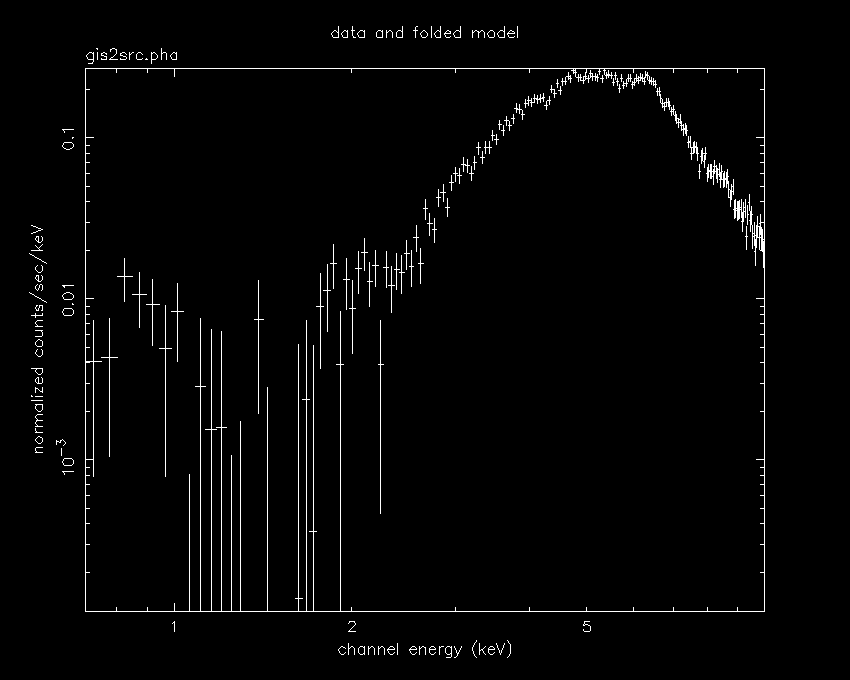
Now lets commence to fit this innocous looking spectra. As usual, lets
start with the standard and omnipresent powerlaw model.
XSPEC>mo pow
Model: powerlaw[1]
Input parameter value, delta, min, bot, top, and max values for ...
Current: 1 0.01 -3 -2 9 10
powerlaw:PhoIndex>
Current: 1 0.01 0 0 1E+24 1E+24
powerlaw:norm>
---------------------------------------------------------------------------
---------------------------------------------------------------------------
Model: powerlaw[1]
Model Fit Model Component Parameter Unit Value
par par comp
1 1 1 powerlaw PhoIndex 1.000 +/- 0.000
2 2 1 powerlaw norm 1.000 +/- 0.000
---------------------------------------------------------------------------
---------------------------------------------------------------------------
Chi-Squared = 3.3933906E+09 using 197 PHA bins.
Reduced chi-squared = 1.7402004E+07 for 195 degrees of freedom
Null hypothesis probability = 0.00
XSPEC>pl
XSPEC>fit
Chi-Squared Lvl Fit param # 1 2
14310.6 -1 -2.383 3.2649E-05
11301.2 -1 -2.154 4.3365E-05
10258.5 -1 -1.970 6.7552E-05
8191.41 -2 -1.368 2.1001E-04
8155.36 -1 -1.371 1.8771E-04
8098.40 -2 -1.416 1.7777E-04
8090.04 -1 -1.417 1.8513E-04
8082.10 -2 -1.403 1.8785E-04
8081.38 -1 -1.403 1.8578E-04
8080.77 -2 -1.406 1.8511E-04
Number of trials exceeded - last iteration delta = 0.6108
Continue fitting? (Y)
..
Continue till the least chi-square value is reached.
..
---------------------------------------------------------------------------
---------------------------------------------------------------------------
Model: powerlaw[1]
Model Fit Model Component Parameter Unit Value
par par comp
1 1 1 powerlaw PhoIndex -1.405 +/- 0.1369E-01
2 2 1 powerlaw norm 1.8569E-04 +/- 0.8896E-05
---------------------------------------------------------------------------
---------------------------------------------------------------------------
Chi-Squared = 8080.686 using 197 PHA bins.
Reduced chi-squared = 41.43941 for 195 degrees of freedom
Null hypothesis probability = 0.00
The best fit chi-square (and reduced chi-square) is extremely poor. See the
best fit model with residual (typing pl ld res). As is always the
case, we have to add an absorption component (wabs or phabs
) for absortpion due to effective Hydrogen column in the direction of the
source
XSPEC>addcomp 1 wabs
Input parameter value, delta, min, bot, top, and max values for ...
Current: 1 0.001 0 0 1E+05 1E+06
wabs:nH>
---------------------------------------------------------------------------
---------------------------------------------------------------------------
Model: wabs[1]( powerlaw[2] )
Model Fit Model Component Parameter Unit Value
par par comp
1 3 1 wabs nH 10^22 1.000 +/- 0.000
2 1 2 powerlaw PhoIndex -1.405 +/- 0.1370E-01
3 2 2 powerlaw norm 1.8575E-04 +/- 0.8897E-05
---------------------------------------------------------------------------
---------------------------------------------------------------------------
Chi-Squared = 7300.136 using 197 PHA bins.
Reduced chi-squared = 37.62957 for 194 degrees of freedom
Null hypothesis probability = 0.00
and fit.
XSPEC>fit
..
..
---------------------------------------------------------------------------
---------------------------------------------------------------------------
Model: wabs[1]( powerlaw[2] )
Model Fit Model Component Parameter Unit Value
par par comp
1 3 1 wabs nH 10^22 21.72 +/- 0.4086
2 1 2 powerlaw PhoIndex 1.342 +/- 0.4250E-01
3 2 2 powerlaw norm 6.3922E-02 +/- 0.5426E-02
---------------------------------------------------------------------------
---------------------------------------------------------------------------
Chi-Squared = 456.1984 using 197 PHA bins.
Reduced chi-squared = 2.351538 for 194 degrees of freedom
Null hypothesis probability = 3.599E-23
The model has improved considerably, but still is not acceptable. Observe
the spectrum, best fit model and its residual.
XSPEC>pl ld delchi
Observe the excess between 6-7 keV.
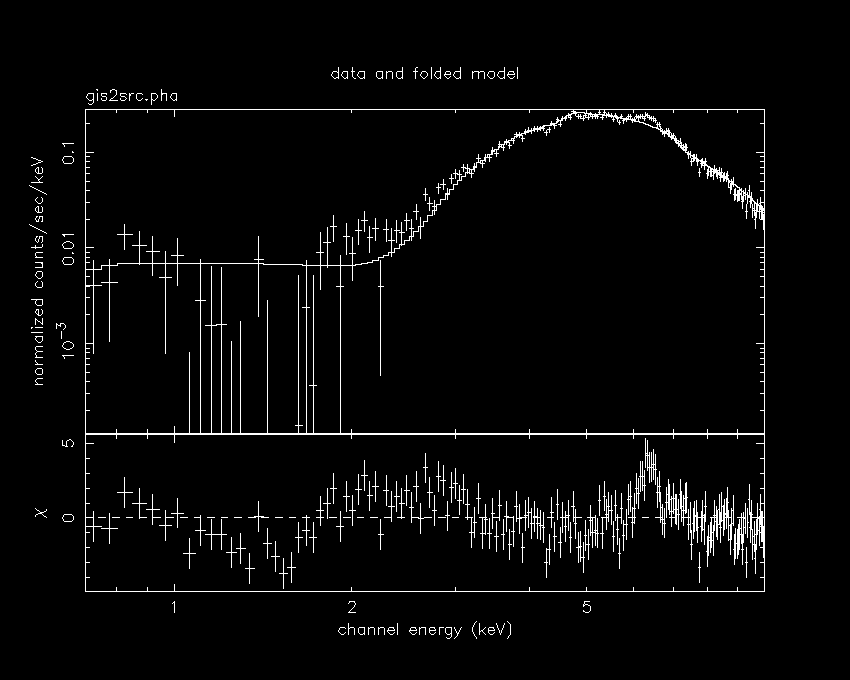
The keyword delchi plots the residuals in terms of sigmas with error
bars of size one. The residual in the low energy region (less than 2 keV)
is due to relatively poor quality data, whereas the excess between 6-7 keV
is due to Fe emission line. Therefore add gaussian line component
to the model.
XSPEC>addcomp 3 ga
Input parameter value, delta, min, bot, top, and max values for ...
Current: 6.5 0.05 0 0 1E+06 1E+06
gaussian:LineE>
Current: 0.1 0.05 0 0 10 20
gaussian:Sigma>
Current: 1 0.01 0 0 1E+24 1E+24
gaussian:norm>
---------------------------------------------------------------------------
---------------------------------------------------------------------------
Model: wabs[1]( powerlaw[2] ) + gaussian[3]
Model Fit Model Component Parameter Unit Value
par par comp
1 3 1 wabs nH 10^22 21.73 +/- 0.4090
2 1 2 powerlaw PhoIndex 1.342 +/- 0.4253E-01
3 2 2 powerlaw norm 6.3927E-02 +/- 0.5438E-02
4 4 3 gaussian LineE keV 6.500 +/- 0.000
5 5 3 gaussian Sigma keV 0.1000 +/- 0.000
6 6 3 gaussian norm 1.000 +/- 0.000
---------------------------------------------------------------------------
---------------------------------------------------------------------------
Chi-Squared = 5.6398118E+08 using 197 PHA bins.
Reduced chi-squared = 2952781. for 191 degrees of freedom
Null hypothesis probability = 0.00
This absurd value of chi-square is due to the arbitrary initial value of
the gaussian line parameters that we have input. Just fit the data and see
the fun.
XSPEC>fit
..
..
---------------------------------------------------------------------------
---------------------------------------------------------------------------
Model: wabs[1]( powerlaw[2] ) + gaussian[3]
Model Fit Model Component Parameter Unit Value
par par comp
1 3 1 wabs nH 10^22 19.72 +/- 0.4490
2 1 2 powerlaw PhoIndex 1.274 +/- 0.4744E-01
3 2 2 powerlaw norm 4.9797E-02 +/- 0.4770E-02
4 4 3 gaussian LineE keV 6.436 +/- 0.4277E-01
5 5 3 gaussian Sigma keV 0.4722 +/- 0.5708E-01
6 6 3 gaussian norm 1.0815E-03 +/- 0.2245E-03
---------------------------------------------------------------------------
---------------------------------------------------------------------------
Chi-Squared = 292.3154 using 197 PHA bins.
Reduced chi-squared = 1.530447 for 191 degrees of freedom
Null hypothesis probability = 3.261E-06
This is a good fit, maybe not as good as the one in the previous exercise,
because the data available in the low energy range is not excellent. Plot
the spectra, best fit model and the residual.
XSPEC>pl ld chi
chi is another keyword of the plot command which gives the
chi-square contribution of each energy bin.
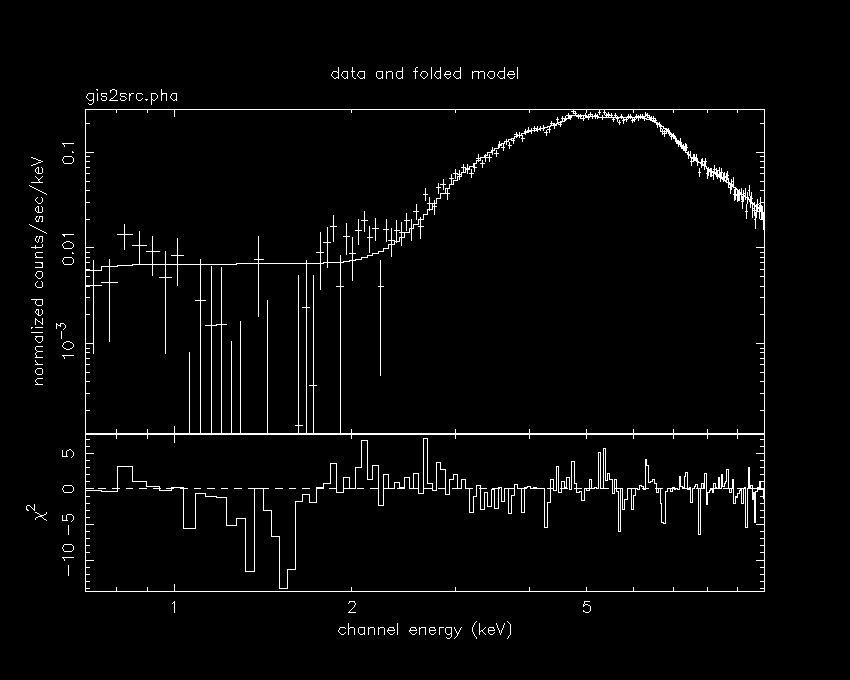
Now you can see that the contribution to chi-square is mainly from the
region <2 keV. Most importantly, the excess between 6-7 keV is no longer
present, vindicating our supposition of the presence of Fe emission line.
You may plot the unfolded spectra.
XSPEC>pl uf
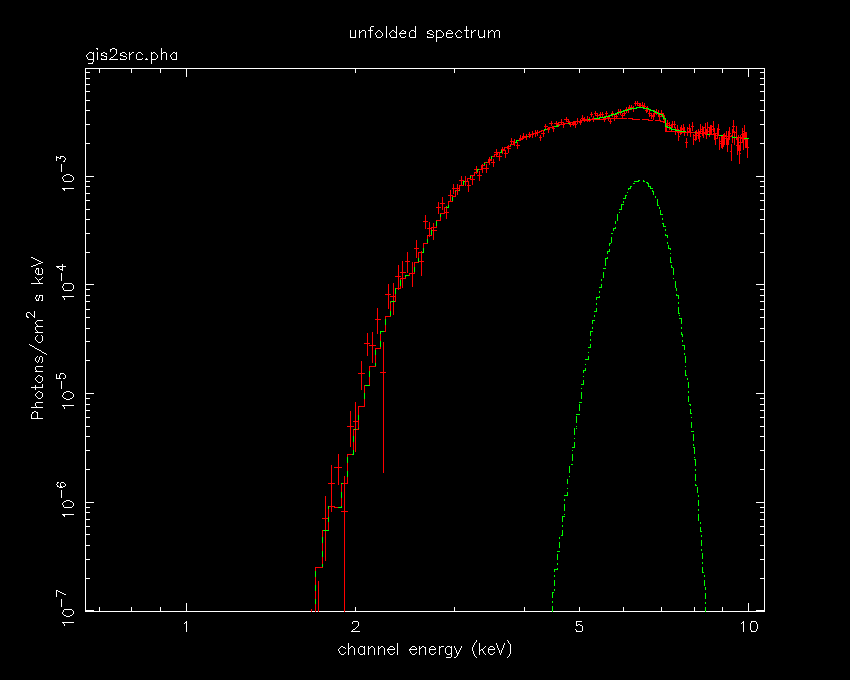
It is possible to see the individual model components in the folded spectra
also.
XSPEC>setp add
To check for other keywords for setplot you type help setpl, in fact you
will get help for every command by typing help followed by the command
name. Typing only help will give a list of all the commands of
xspec.
XSPEC>pl ld chi
You can see that you need to adjust the scale of the y axis of the sepctrum
to get a proper figure of the folded spectra along with the individual model
components. Type iplot, this command starts the QDP/PLT subroutine.
QDP (quick and dandy plotter) is a program used for all the front end plotting
program for FTOOLS and XANADU. Once you get the PLT prompt you can set the
range of the y-axis as per the following syntax. You may browse through the
main commands of QDP/PLT and their usage by the help command while
in the PLT prompt.
XSPEC>iplot
PLT>r y .001
PLT>pl
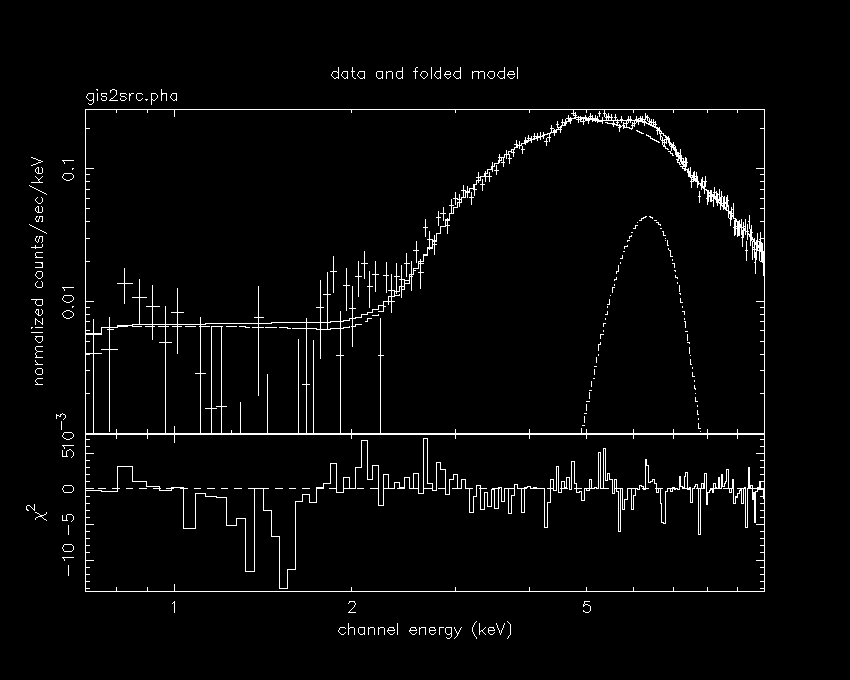
Notice the Fe emission line among the continuum components (powerlaw
).
You can quit QDP/PLT anytime by typing quit and you will come back
to xspec. Lets quit the package and get on with the next exercise.
PLT>quit
You can also see the number of X-ray photons detected in each energy channel
xspec>pl counts
xspec>quit
The hydrogen column density towards this source that we have derived is very
high. Though this source
is in the galactic plane, the measured column density is much larger than
the average galactic hydgoren
column density in this direction of the sky. This indicates that most of
the absorbing material is very close
to the source, probably circumstellar material. A further evidence for this
is that the column density is
found to vary significantly with time, which must be related to the level
of activity of the companion star.
The centre of the gaussian line profile is ~6.4 keV. This indicates that
the absorbing material, which also
gives rise to the iron K-alpha fluorescence emission is relative cold and
not very highly ionised.
Our next exercise will be to fit more than one emission line.
|


